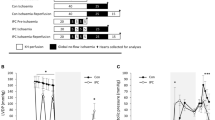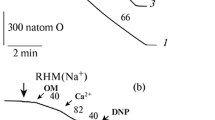Summary
Initial Polytron treatment with subsequent exposure to the bacterial proteinase Nagarse has been shown to result in the isolation of two distinct populations of cardiac mitochondria, subsarcolemmal and interfibrillar mitochondria, respectively. Although these populations have been shown to possess distinct biochemical properties, few studies have been reported which document the potential differences in their response to pathological insult. We therefore examined the effect of acute hypoxia with or without reoxygenation as well as treatment with phosphate on oxidative phosphorylation on both groups of mitochondria. Freshly-isolated interfibrillar mitochondria (IFM) exhibited significantly higher respiratory values, with the exception of the ADP:O ratios, than subsarcolemmal mitochondria (SLM). With pyruvate-malate as respiratory substrate, 40 minutes hypoxia alone produced no effect on SLM whereas a stimulation in respiration was seen in IFM. A 40-minute reoxygenation period depressed the oxidative phosphorylation rate in SLM whereas it was stimulated in IFM. These treatments did not produce any effect in either population when succinate was the substrate of choice. Because of the latter observation, the possibility that increased lability of complex I of the electron transport chain accounted for the differences associated with NAD-linked substrates was studied by assessing NADH oxidation of sonicated mitochondria following the treatments. SLM exhibited enhanced permeability to exogenous NADH as well as increased sensitivity to sonication following either hypoxia or hypoxia/reoxygenation compared to IFM.
Compared to hypoxia/reoxygenation, increasing concentrations of phosphate (5–15 mM) produced a marked depression in oxidative phosphorylation of SLM whereas IFM were relatively resistant. The toxic effects of phosphate were much more evident with pyruvate-malate as substrates; with succinate, oxidative phosphorylation of IFM was not depressed by phosphate whereas only a slight depression was observed with SLM. The latter population similarly exhibited reduced NADH oxidation following phosphate treatment whereas IFM were unaffected.
Our studies show a differential sensitivity of two mitochondrial populations to hypoxia/reoxygenation, and, more markedly to phosphate. Since these effects were much less pronounced with succinate-linked respiration and since they were associated with defective NADH oxidation in SLM, it is suggested that the differences between the two populations may be accounted for by the increased lability of complex I of SLM due to hypoxia/reoxygenation or phosphate.
Similar content being viewed by others
References
Jennings RB, Ganote CE: Mitochondrial structure and function in acute myocardial ischemic injury. Circ Res 38 (Suppl 1): 80–89, 1976
Rouslin W: Mitochondrial complexes I, II, III, IV and V in myocardial ischemia and autolysis. Am J Physiol 244: H743-H748,1983
Schwartz A, Wood JW, Allen JC, Bornet EP, Entman ML, Goldstein MA, Sordahl LA, Suzuki M: Biochemical and morphological correlates of cardiac ischemia. Am J Cardiol 32: 46–61, 1973
Trump BF, Mergner W, Kahng MW, Saladino AJ: Studies on the subcellular pathophysiology of ischemia. Circulation 53 (Suppl 1): 17–26, 1976
Willerson JT, Scales F, Mukherjee A, Platt M, Templeton GH, Fink GS, Buja LM: Abnormal myocardial fluid retention as an early manifestation of ischemic injury. Am J Pathol 87: 159–188, 1977
Wood JM, Harley HG, Entman ML: Biochemical and morphological correlates of acute experimental myocardial ischemia in the dog. Circ Res 44: 52–61, 1979
Watts JA, LaNoue KF: Effects of Ca++ antagonism on energy metabolism: Call and heart function after ischemia. Am J Physiol 238: H909-H916, 1980
Jennings RB, Herdson PB, Sommers HM: Structural and functional abnormalities in mitochondria isolated from ischemic dog myocardium. Lab Invest 20: 548–557, 1969
Pinsky WW, Lewis RM, McMillin-Wood JB, Hara H, Hartley CJ, Gillette PC, Entman ML: Myocardial protection from ischemic arrest: Potassium and verapamil cardioplegia. Am J Physiol 240: H326-H335, 1981
Page E, McCallister LP: Quantitative electron microscopic description of heart muscle cells. Am J Cardiol 31: 172–181, 1973
Palmer JW, Tandler B, Hoppel CL: Biochemical properties of subsarcolemmal and interfibrillar mitochondria isolated from rat cardiac muscle. J Biol Chem 252: 8731–8739, 1977
Stenger RJ, Spiro D: Structure of the cardiac muscle cell. Am J Med 30: 653–665, 1961
Tomanek RJ, Karlsson VL: Myocardial ultrastructure of young and senescent rats. J Ultrastruct Res 42: 201–220, 1973
McMillin-Wood J, Wolkowicz CA, Take CA, Goldstein MA, Entman ML: Calcium uptake by two preparations of mitochondria from heart. Biochim Biophys Acta 591: 251–265,1980
Van Jaarsveld H, Lochner A: Oxidative phosphorylation function of two mitochondrial preparations from heart: Effects of ischemia and cytochrome C. Basic Res Cardiol 77:388–403,1982
Matlib MA, Rouslin W, Vaghy PL, Schwartz A: Isolation of cardiac muscle mitochondria: An update. In: A Schwartz (ed) Methods in Pharmacology. Plenum Press, New York, 1985, vol. 5, pp 25–37
Lowry OH, Rosebrough NJ, Farr AL, Randall RJ: Protein measurement with the folin phenol reagent. J Biol Chem 193: 265–275,1951
Karmazyn M: Prostaglandins stimulate calcium-linked changes in heart mitochondrial respiration. Am J Physiol 251: H141-H147, 1986
Edoute Y, Kotze JCN, Locher A: Oxidative phosphorylation rate: An index for evaluation of mitochondrial ischemia. J Mol Cell Cardiol 11: 831–833, 1979
Green DE, Ziegler DM: Electron transport particles. Methods Enzymol 6: 416–424, 1963
Palmer JW, Tandler B, Hoppel CL: Heterogeneous response of subsarcolemmal heart mitochondria to calcium. Am J Physiol 250: H741-H748, 1986
Allen DG, Morris PG, Orchard CH, Pirolo JS: A nuclear magnetic resonance study of metabolism in the ferret heart during hypoxia and inhibition of glycolysis. J Physiol 361: 185–204,1985
Reimer KA, Jennings RB: Myocardial ischemia, hypoxia and infarction. In: HA Fozzard, E Haber, RB Jennings, AM Katz and HE Morgan (eds) The Heart and Cardiovascular System. Raven, New York, 1986, vol. 2, pp 1133–1201
Fuller EO, Goldberg DI, Starnes JW, Sacks LM, Delivoria-Papadopoulos M: Mitochondrial respiration following acute hypoxia in the perfused rat heart. J Mol Cell Cardiol 17: 71–81,1985
Pelikan PCD, Niemann JT, Xia G, Jagels G, Criley JM: Enhancement of mitochondrial oxidative phosphorylation capability by hypoperfusion in isolated perfused rat heart. Circ Res 61: 880–888, 1987
Mukherjee A, Wong TM, Templeton G, Buja LM, Willerson JT: Influence of volume dilution, lactate, phosphate, and calcium on mitochondrial functions. Am J Physiol 237: H224-H238,1979
Vaghy PL, Matlib MA, Szekeres L, Schwartz A: Protective effects of verapamil and diltiazem against inorganic phosphate induced impairment of oxidative phosphorylation of isolated heart mitochondria. Biochem Pharmacol 30: 2603–2610, 1981
Kubler W, Katz AM: Mechanism of early ‘pump’ failure of the ischemic heart: Possible role of adenosine triphosphate depletion and inorganic phosphate accumulation. Am J Cardiol 40: 467–471, 1977
Yoon SB, McMillin-Wood JB, Michael LH, Lewis RM, Entman ML: Protection of canine cardiac mitochondrial function by verapamil-cardioplegia during ischemia arrest. Circ Res 56: 704–708, 1985
Tzagoloff A: The Electron Transfer Chain in Mitochondria. In: A Tzagoloff (ed) Mitochondria. Plenum Press, New York, 1982, pp 61–109
Van Belle H, Wynants J, Xhonneux R, Flameng W: Changes in creatine phosphate, inorganic phosphate, and the purine pattern in dog hearts with time of coronary artery occlusion and effect thereon of mioflazine, a nucleoside transport inhibitor. Cardiovasc Res 20: 658–664, 1986
Kentish JC, Allen DG: Is force production in the myocardium directly dependent upon the free energy of ATP-hydrolysis? J Mol Cell Cardiol 18: 879–882, 1986
Kusuoka H, Weisfeldt ML, Zweier JL, Jacobus WE, Marban E: Mechanism of early contractile failure during hypoxia in intact ferret heart. Circ Res 59: 270–282, 1986
Author information
Authors and Affiliations
Rights and permissions
About this article
Cite this article
Duan, J., Karmazyn, M. Acute effects of hypoxia and phosphate on two populations of heart mitochondria. Mol Cell Biochem 90, 47–56 (1989). https://doi.org/10.1007/BF00225220
Received:
Accepted:
Issue Date:
DOI: https://doi.org/10.1007/BF00225220




